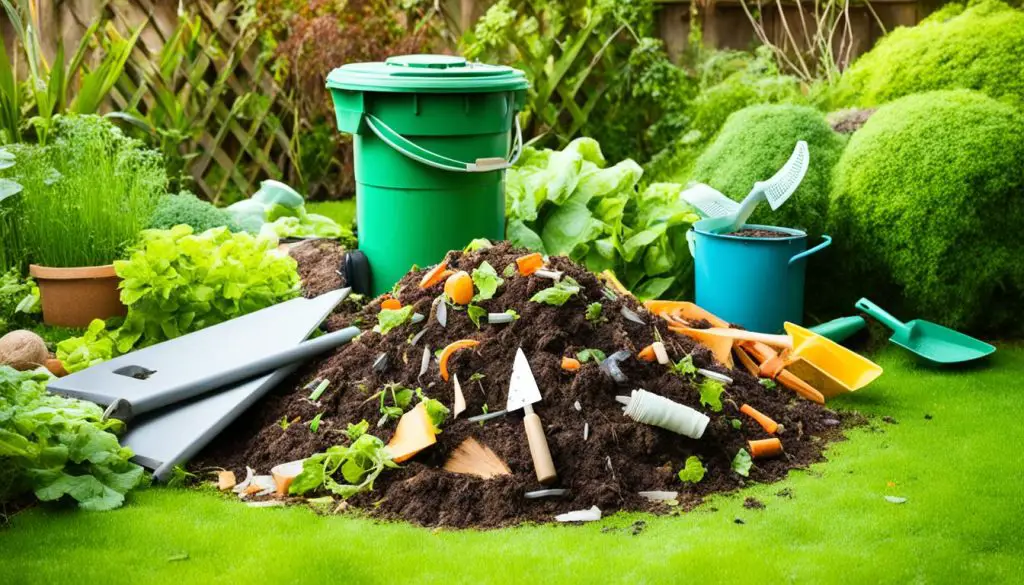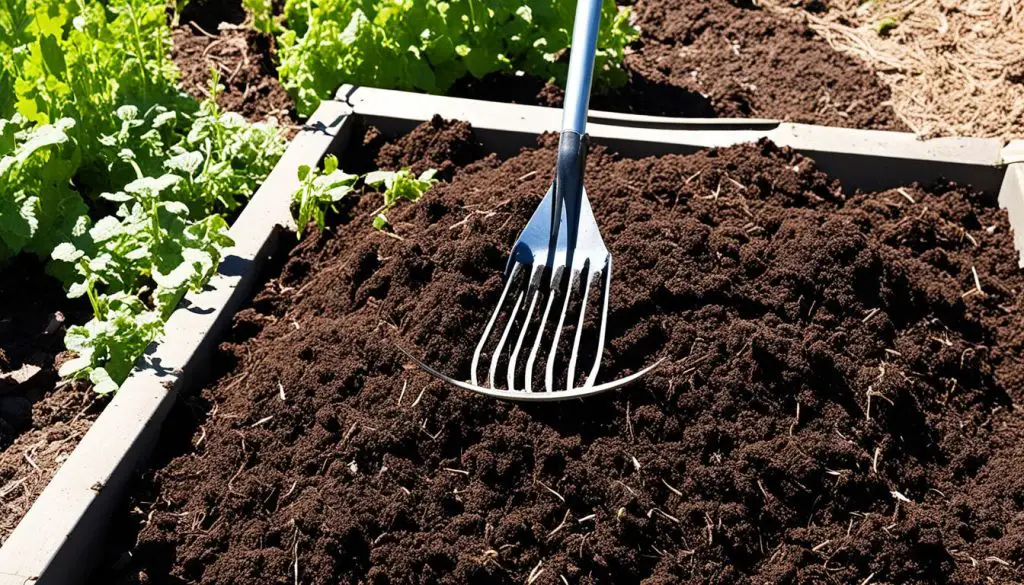Did you know that nearly half of your household waste could be turned into rich, valuable compost? By learning how to start composting at home, you can transform your kitchen scraps and yard waste into “black gold” for your garden. It’s an effective way to recycle, reduce waste, and create a healthier environment right from your own backyard.
Composting at home is more accessible than you might think. It involves gathering compostable materials, such as food scraps and yard clippings, and allowing them to decompose into nutrient-rich soil. Contrary to common belief, home composting systems are not complicated and don’t require a lot of space. In fact, creating compost at home can be accomplished with minimal effort and a few basic supplies.
The benefits are substantial: composting can reduce your household waste, diminish reliance on chemical fertilizers, and improve soil quality for lush, thriving plants. Whether you opt for a simple compost pile, a bin, or a more sophisticated composting method, you can be part of sustainable waste management and benefit your garden simultaneously. Ready to dive in and start composting at home? Here’s your guide to get started.
Key Takeaways
- Nearly 50% of household waste can be composted.
- Composting reduces the need for chemical fertilizers.
- Home composting systems can be simple and space-efficient.
- Composting boosts soil quality, promoting healthier plants.
- Starting compost at home helps in sustainable waste management.
Understanding the Benefits of Composting
Composting transforms household organic waste into a resource that benefits both the environment and your garden. This process not only aids in waste management but also enriches the soil and helps combat climate change.
Environmental Impact
The environmental benefits of composting are profound. By diverting food waste from landfills, composting significantly reduces greenhouse gas emissions, particularly methane. Methane is a potent greenhouse gas that contributes to climate change. Through composting, we embrace waste management methods that support a greener planet.
Improving Soil Quality
Another key advantage of composting is soil enrichment through compost. Compost acts as a natural fertilizer, enhancing soil structure, increasing its water retention capacity, and promoting healthy plant growth. Gardeners find that using compost leads to healthier, more productive plants, reducing the need for chemical fertilizers and conserving water.
Reducing Organic Waste
When it comes to organic waste reduction, composting plays a crucial role. By turning kitchen scraps, garden clippings, and other organic materials into compost, we can significantly reduce the waste that would otherwise end up in landfills. This reduction in organic waste helps mitigate the environmental pollutants produced by landfills, such as methane and leachate.
| Benefits | Description |
|---|---|
| Environmental Protection | Reduces greenhouse gas emissions by keeping organic waste out of landfills. |
| Soil Enrichment | Improves soil quality by adding essential nutrients and enhancing its structure. |
| Organic Waste Reduction | Decreases the volume of organic waste ending up in landfills, lowering the environmental harm. |
The Basics of Composting: How to Start Composting at Home
Embarking on the journey of composting at home can be a rewarding endeavor, benefiting both your garden and the environment. This section will guide you through essential steps, covering compost method selection, identifying an ideal location, and gathering the right ingredients for a productive compost pile.
Choosing the Right Composting Method
Your compost method selection depends on your living situation, particularly on the amount of space you have. Urban dwellers might lean towards kitchen composting, using small indoor bins designed to minimize odor and mess. Conversely, those with larger yards can explore backyard composting through methods like compost bins, tumblers, or open compost piles.
Selecting a Composting Location
Picking the right spot for your compost bin setup is crucial. Ideally, choose a shaded location in your backyard to prevent the compost from drying out too quickly. A well-drained area is preferrable, which helps manage moisture levels effectively. If you’re starting a compost pile, ensure it is easily accessible yet not too close to your living areas to avoid potential odors.

Gathering Compost Ingredients
Successful composting hinges on the balance of green and brown materials. Green materials, like food scraps and fresh grass clippings, provide essential nitrogen. Brown materials, such as dry leaves, straw, and cardboard, offer carbon, which helps in aeration and maintaining structure. Layering these materials properly and ensuring adequate moisture aid in the decomposition process, crucial for starting a compost pile effectively.
The following table highlights common compost ingredients and how to balance them for optimal composting:
| Category | Examples | Function |
|---|---|---|
| Green Materials | Fruit scraps, vegetable peels, coffee grounds | Provide nitrogen |
| Brown Materials | Dry leaves, straw, cardboard | Provide carbon |
Materials to Compost and What to Avoid
Composting is an art of balancing elements to create nutrient-rich soil. Understanding which materials to add and which to avoid is essential for successful composting.
Green Materials
Green materials, also known as nitrogen-rich ingredients, are vital for the composting process. These include:
- Fruit and vegetable scraps
- Grass clippings
- Coffee grounds
- Tea bags
- Kitchen scraps
These items provide the nitrogen necessary to break down compostable materials into rich, nutrient-dense compost.
Brown Materials
On the other hand, brown materials are carbon-rich ingredients essential for developing a balanced compost. They include:
- Dried leaves
- Straw
- Cardboard
- Wood chips
- Paper scraps
By adding these, you provide the carbon needed to balance the nitrogen from green materials, crucial for efficient and odor-free garden composting.
Materials to Avoid
Knowing what not to compost is just as important as knowing what to include. Certain materials can disrupt the composting process or attract pests. Avoid adding the following:
- Diseased plants
- Pet droppings
- Meat and dairy products
- Treated wood
- Greasy or oily foods
Keeping these items out will ensure that your kitchen compost ingredients remain healthy and pest-free, resulting in high-quality final compost.
| Category | Materials |
|---|---|
| Green Materials | Fruit scraps, vegetable scraps, grass clippings, coffee grounds, tea bags |
| Brown Materials | Dried leaves, straw, cardboard, wood chips, paper scraps |
| Materials to Avoid | Diseased plants, pet droppings, meat, dairy, treated wood, greasy foods |
By carefully selecting your compostable materials and being aware of what not to compost, you can create a thriving compost system that will benefit your garden for years to come.
Maintaining and Troubleshooting Your Compost
Effective compost maintenance ensures a healthy compost pile and optimal results. Regularly maintaining your compost includes proper layering, aeration, and moisture management. Additionally, addressing common compost issues can prevent any potential problems.
Proper Layering and Aeration
Adequate layering and compost pile aeration are critical for maintaining a productive compost heap. Start by alternating layers of green materials, rich in nitrogen, with brown materials, high in carbon. This balance is essential for promoting microbial activity and decomposition. Regularly turning your compost pile enhances aeration, supplying the necessary oxygen for the microorganisms that break down the organic material. Inserting sticks or pipes into the compost can further aid airflow, ensuring efficient composting.

Managing Moisture Levels
Managing compost moisture levels is crucial to ensure that your compost pile remains active and effective. Ideal moisture content for compost is similar to a damp sponge—not too dry and not too wet. Overly saturated compost can lead to anaerobic conditions, resulting in foul odors. Conversely, a too-dry compost pile will slow down decomposition. Regularly monitor and adjust the moisture levels by adding water or dry materials as necessary.
Common Problems and Solutions
While managing compost moisture and compost pile aeration, you may encounter common issues. Troubleshooting compost issues can prevent these problems from escalating. For instance, unpleasant odors usually indicate too much nitrogen and not enough oxygen; this can often be resolved by turning the compost and adding brown materials. Pests in the compost pile can be deterred by avoiding meat, dairy, and oily foods and ensuring the compost is properly covered. Identifying and correcting these common problems ensures a healthy composting process.
Conclusion
Embracing composting at home offers myriad benefits, not only for the environment but also for your organic gardening endeavors. By turning kitchen and garden waste into rich, nutrient-filled compost, you can enhance soil quality and promote healthier plant growth. This practice underscores the true essence of waste recycling, transforming what was once deemed rubbish into valuable resources.
Achieving composting success requires a balanced approach to selecting materials and maintaining the compost pile. Green materials like food scraps and brown materials such as dried leaves play a pivotal role. With diligent layering, adequate aeration, and moisture management, the process becomes seamless, contributing to sustainable compost practices.
The benefits of home composting extend beyond garden aesthetics. It plays an integral role in waste recycling, reducing the waste directed to landfills, and supporting a more eco-friendly lifestyle. Whether you’re an experienced gardener or a novice, integrating composting into your daily routine can significantly benefit your sustainable gardening practices, fostering a healthier, greener environment for all.
Leave a Reply